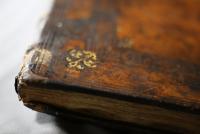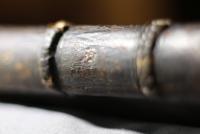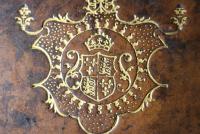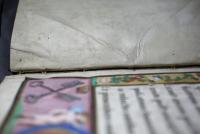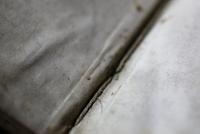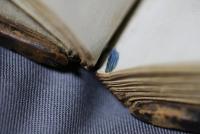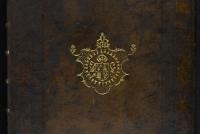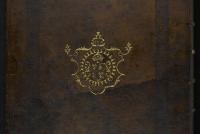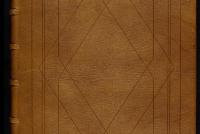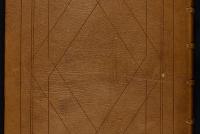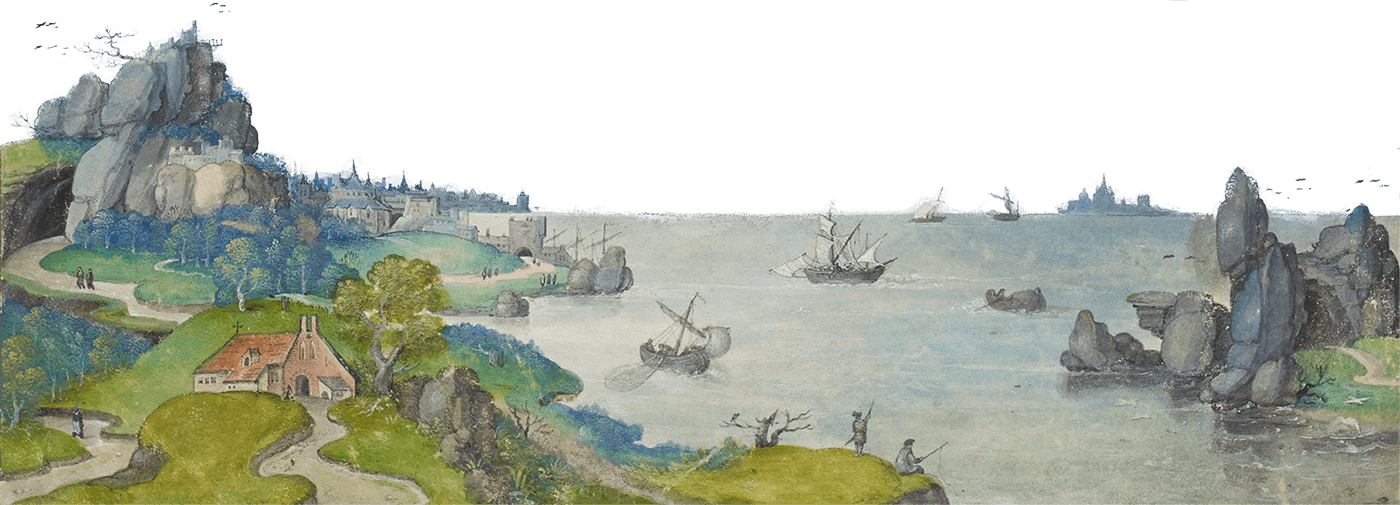The Binding of the Wolsey Gospel Lectionary
Published on 11/05/2017 | Originally published 2005, draft for a CD-ROM
The manuscript gospel book for Cardinal Wolsey is bound in brown calf over pasteboard, tooled in blind and gold. The binding measures 415 x 310 x 35mm. and the pasteboards are 5-6mm thick.
The manuscript is sewn on eight split alum-tawed supports, using a rather coarse hemp thread (with an S twist) in what appears to be a herringbone stitch. The supports have been laced into the boards in straight lines perpendicular to the spine, forming eight raised bands; the two kettle stitches near head and tail show up as low bands. The spine has two narrow compartments at head and tail, and nine compartments with gold-tooled five-petalled conventional flower head in each. The endbands are now missing, but were once present, as traces and remnants of blue silk tie-downs show. There are no visible signs of lacing-in hols for the endband cores, but as the boards are rather worn and have been repaired, these could easily have been obscured. There are traces of two pairs of silk ties and the edges of the leaves have been gilt.
At front there is a parchment paste-down conjugate with one free parchment end-leaf (sewn through the fold); a second free parchment end-leaf is conjugate with a stub which shows beneath the paste-down. At the back the end-leaves form part of the last eight-leaf section: the paste-down being conjugate with the first leaf and one free end-leaf being conjugate with the second leaf of the last section.
The brown calf covers are tooled in blind with three lines, running close to the edges of the boards; a roll showing heads in medallions (Oldham HMa(9)7781) with lines at both sides forms the borders of a large centre panel. At the outer corners of the panel are large composite fleurons tooled in gold, while in the centre gouges (curved lines) and branch tools form a cartouche, with a triangular tool at the top and fleurons at both sides of the upper branch tools, all tooled in gold. On a dotted ground in the centre of the cartouche is a circle, surrounded with flame tools, which contains the crowned Tudor arms supported by two leafy S-shaped tools, also tooled in gold. All tools have been identified as having belonged to the King Edward and Queen Mary Binder.
This binder worked in London for King Henry VIII, members of his court and other collectors, and continued during the reign of Queen Mary at least until 1558, but possible for another ten years until 1568. The earliest imprint of a book with a binding from this shop is 1530, but as this book was printed in Marburg, the binding could well be later. The binding of the gospel book is therefore an early example of this binder’s work, but well made and carefully tooled.
It is likely that the gospel book was written before, but illuminated after Wolsey knew that he would become bishop of Winchester, therefore after early October 1528. The manuscript itself is lavishly decorated with Wolsey’s initials, arms, and insignia.
Its pair, the epistolary at Christ Church, Oxford, was finished first and has the date 1528 in one of its borders. This manuscript has alas been rebound more than once. It is now in a binding of brown goatskin over wooden boards, made by the Eddington binder in 1981. This replaced an earlier, possibly eighteenth-century binding of reverse calf also over wooden boards. The epistolary has been re-sewn and has six supports, but it is impossible to see whether earlier sewing holes have been reused or whether it had a different sewing pattern for its earlier bindings.
It is likely that both manuscripts, being fine and luxurious, would have been bound soon after their completion. It is impossible to say what the original binding of the epistolary looked like, but it probably had wooden boards, as it would be unusual for an eighteenth-century binder to replace pasteboards with wood without a very good reason, and it may already have been sewn on six supports.
It may seem difficult to understand why Wolsey’s gospel book is decorated with Henry VIII’s arms. However, it was not unusual for courtiers to use the royal arms on their personal bindings and the presentation binding for Wolsey of Whittington’s Epigrams (c.1519) is decorated with a block boldly displaying three Tudor emblems. It is less easily explained why the gospel book would have been given boards of a different material from those of its pair; both manuscripts being fairly thin would not need wooden boards. The gospel book shows no sign of having been re-sewn, and if it was rebound, the original sewing holes must have been reused. It is very unlikely that the original binding had wooden boards, as the eight sewing supports are only 5cm apart and in order to be laced in, two rows of holes per support would have to be drilled in the wood, which would have weakened the boards severely.
We are therefore faced with a conundrum to which here are several possible answers, none of which can be proven. It is possible, but highly unlikely, that the epistolary was bound in wooden boards and the gospel book in pasteboards; alternatively, both could have been bound in wooden boards, each with a different sewing pattern, risking the splitting of the boards of the gospel book; this is equally unlikely. It is just possible that the epistolary was bound (in wooden boards) soon after its completion and the gospel book (for whatever reason) was left unbound for a minimum of six months (from April 1529, when Wolsey was elevated to the see of Winchester, until October of that year)2 and that its first binding was only made after the manuscript had come into Henry’s possession. Both manuscripts could have been sewn originally on eight supports with boards made of pasteboard, which in the case of the epistolary would then have been replaced later with wood, re-sewing this manuscript on six supports. The gospel book could have been rebound at an early stage when Wolsey’s books were sequestered to Henry VIII (in October 1529 or in November 1530), and either not re-sewn or re-sewn using the existing sewing holes. The decoration, using a combination of blind and gold, is not of the most lavish kind, but perfectly suitable for a book in Henry’s library. What in that case its original (Wolsey) binding looked like remains a matter of conjecture.
1. Oldham, J. Basil. English blind-stamped bindings. Cambridge: Cambridge UP, 1952 Back to text
2. see James Carley “The subsequent fate of Wolsey’s books” (The Wolsey Gospel Lectionary: the making & meaning of a sixteenth-century masterpiece [CD-ROM]. Oxford: Magdalen College, 2005) Back to text


